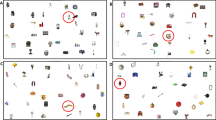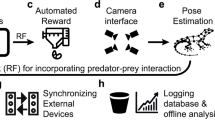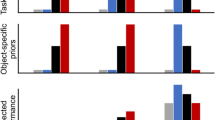Abstract
The response of predators to a choice of prey is influenced by prey frequency, density and visibility, and the type of background against which the predator is searching. These factors affect the likelihood that frequency-dependent prédation will maintain polymorphisms. Experiments have been carried out in which human subjects searched a computer monitor screen for 'prey' objects (Ws and commas) against a background of randomly placed blocks of Ms and full stops (points). The frequency and density of the prey were varied, as well as their chance of occurring against the background element on which they are most cryptic. The display moved, so that only part could be seen at a time and the background frequency was also varied between trials. Under the conditions of most of the trials, rare objects were found more than proportionally (selection was anti-apostatic). Niche-choice by prey reduced this effect, as did a reduction in density. The relative visibility of the two prey objects changed with background frequency, as would be expected, but so did the frequency dependence. The data suggest that at one end of the range of background frequency the anti-apostatic effect changes to a pro-apostatic one which would maintain polymorphism. This result indicates that background variability may itself be an important factor in determining whether predators behave in such a way as to develop visible polymorphisms in prey species.
Similar content being viewed by others
Article PDF
References
Allen, J A. 1988. Frequency-dependent selection by predators. Phil Trans Roy Soc B, 319, 485–503.
Allen, J A, and Anderson, K P. 1984. Selection by passerine birds is anti-apostatic at high density. Biol J Linn Soc, 23, 237–246.
Bond, A B. 1983. Visual search and selection of natural stimuli in the pigeon: the attention threshold hypothesis. J Exp Psychol, 9, 292–306.
Cain, A J. 1977. The uniqueness of the polymorphism in Cepaea (Pulmonata: Helicidae) in western Europe. J Conch, 29, 129–136.
Clarke, B. 1962. Balanced polymorphism and the diversity of sympatric species. In: Nichols, D. (ed.) Taxonomy and Geography, Systematics Association, Oxford, pp. 47–70.
Clarke, B. 1969. The evidence for apostatic selection. Heredity, 24, 347–353.
Clarke, B, Arthur, W, Horsley, D T, and Parkin, D T. 1978. Genetic variation and natural selection in pulmonate molluscs. In: Fretter, V. and Peake, J. (eds) Pulmonates, Vol 2A, Systematics, Evolution and Ecology, Academic Press, New York, pp. 219–270.
Cook, L M. 1986a. Polymorphic snails on varied backgrounds. Biol J Linn Soc, 29, 89–99.
Cook, L M. 1986b. Site selection in a polymorphic mangrove snail. Biol J Linn Soc, 29, 101–113.
Cook, L M, and Miller, P. 1977. Density-dependent selection on polymorphic prey — some data. Am Nat, 111, 594–598.
Endler, J A. 1988. Frequency-dependent predation, crypsis and aposematic coloration. Phil Trans Roy Soc B, 319, 505–523.
Gendron, R P. 1987. Models and mechanisms of frequency-dependent predation. Am Nat, 130, 603–623.
Gendron, R P, and Staddon, J E R. 1984. A laboratory simulation of foraging behaviour: the effect of search rate on the probability of detecting prey. Am Nat, 124, 407–415.
Greenwood, J J D. 1984. The functional basis of frequency-dependent food selection. Biol J Linn Soc, 23, 177–199.
Greenwood, J J D, Blow, N C, and Thomas, G E. 1984a. More mice prefer rare food. Biol J Linn Soc, 23, 211–219.
Greenwood, J J D, and Elton, R A. 1979. Analysing experiments on frequency-dependent selection by predators. J Anim Ecol, 48, 721–737.
Greenwood, J J D, Johnston, J P, and Thomas, G E. 1984b. Mice prefer rare food. Biol J Linn Soc, 23, 201–210.
Horsley, D T, Lynch, B M, Greenwood, J J D, Hardman, B, and Mosley, S. 1979. Visual selection by birds when density of prey is high. J Anim Ecol, 48, 483–490.
Murdoch, W W, and Oaten, A. 1975. Predation and population stability. Adv Ecol Res, 9, 1–131.
Tucker, G M, and Allen, J A. 1988. Apostatic selection by humans searching for computer-generated images on a colour monitor. Heredity, 60, 329–334.
Author information
Authors and Affiliations
Rights and permissions
About this article
Cite this article
Cook, L., Kenyon, G. Frequency-dependent selection with background heterogeneity. Heredity 66, 67–73 (1991). https://doi.org/10.1038/hdy.1991.9
Received:
Issue date:
DOI: https://doi.org/10.1038/hdy.1991.9



